Recommender tutorial
Recommender boxes
This tutorial will guide you through the integration of a recommender experience and show interactions between different services and APIs.
Use the recommender service to implement personalized recommender boxes such as the one depicted in the image.
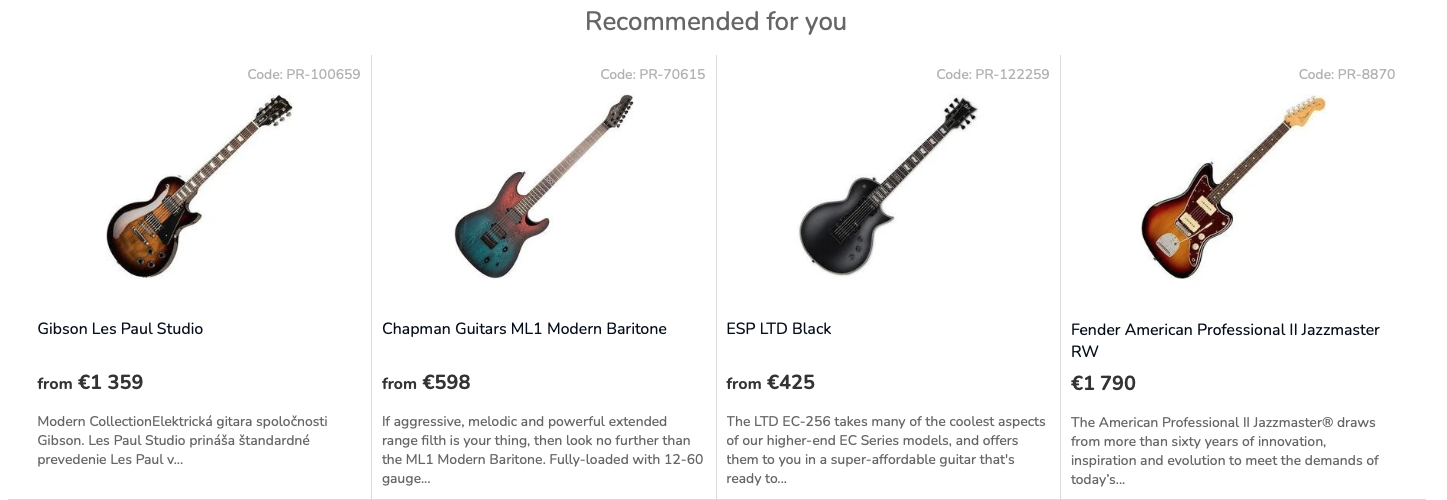
Define recommender models
To start, you will need a recommender model which specifies the logic used to select the products into the recommender box.
You can create the models yourself in the Luigi's Box application in the Recommendations > Recommenders setup section.
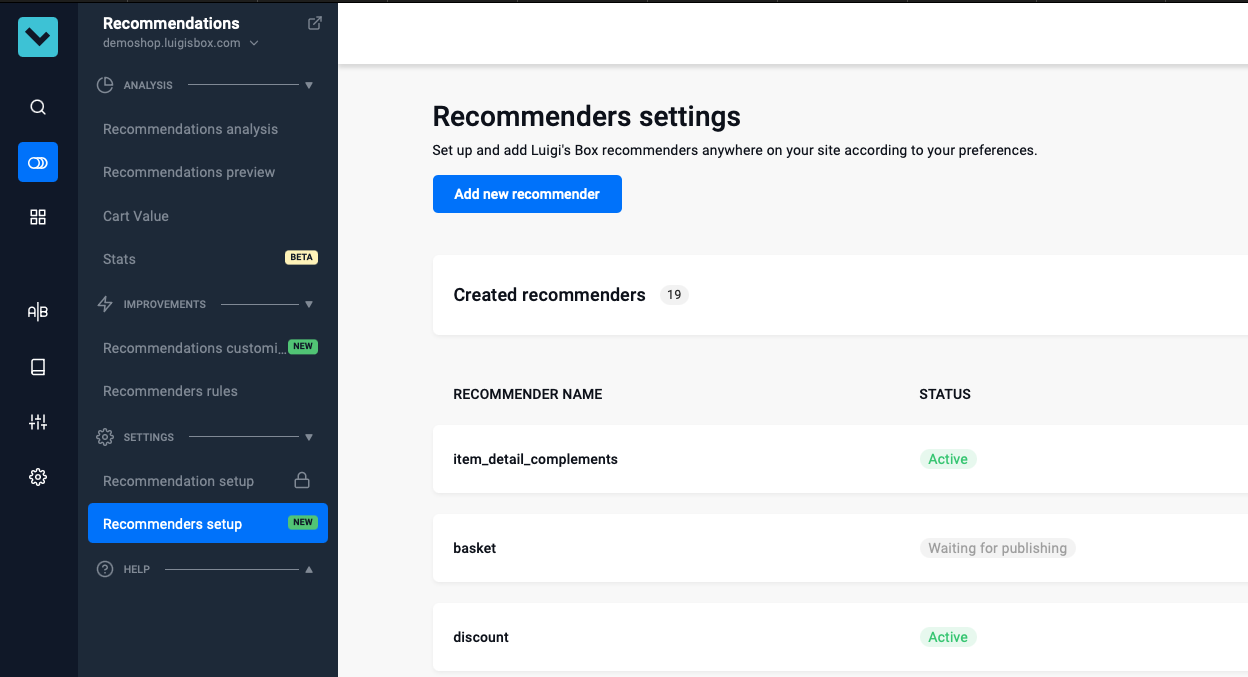
Click the "Add new recommender" button and follow the instructions.
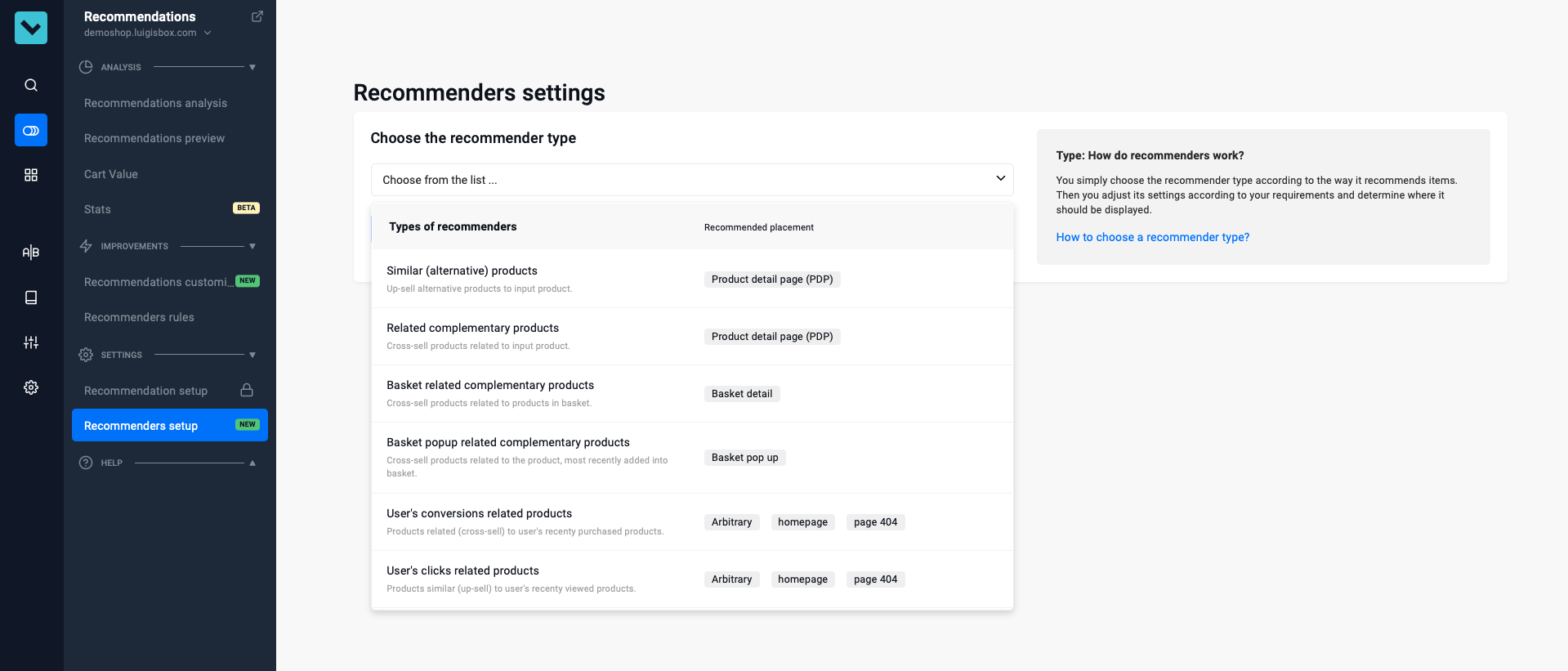
When you are done with the setup you will see the recommender model name assigned by the system (such as item_detail_complements). Note it down as you will need it to make API requests.
Make a request to recommender API
Make a request to the recommender API. This is a POST request with a JSON payload.
POST https://live.luigisbox.com/v1/recommend?tracker_id=<tracker_id>
[
{
"item_ids": ["PR-15553"],
"recommendation_type": "item_detail_complements",
"recommender_client_identifier": "item_detail_complements",
"size": 4,
"user_id": "<transient_user_id>"
}
]
Tips
- Note that the payload is an array, as you can ask for several recommendations in a single request (more on that later)
item_idsis the array of identities for which you are asking the recommendations. They must point to valid catalog identities. You will typically see these scenarios: empty array for cases where there is no input item (such as when recommending on a home page), a single-element array (when recommending for a specific product) or multi-element array (when recommending for several products at once, typically in the basket).recommendation_typeis the model name you have obtained in the previous steprecommender_client_identifieris the recommender name for analytics. Feel free to use the same name as for therecommendation_type.user_idis the transient user id from the_lbcookie (unless the user is signed in, more on that later)
Render recommendation box
The recommender API response includes a metadata fields and the hits field which you should be already familiar with from implementing autocomplete and search endpoints. The structure of the hits attribute contains all the product data you have indexed.

[
{
"generated_at": "2025-01-06T23:34:59.585570",
"hits": [
{
"url": "PR-100659",
"attributes": {
"image_link": "https://cdn.myshoptet.com/usr/demoshop.luigisbox.com/user/shop/detail/1778046_gibson-les-paul-studio.jpg",
"title": "Gibson Les Paul Studio",
"price_amount": 1359,
"web_url": "/gibson-les-paul-studio/"
},
"type": "item"
},
{
"url": "PR-70615",
"attributes": {
"image_link": "https://cdn.myshoptet.com/usr/demoshop.luigisbox.com/user/shop/detail/1777002_chapman-guitars-ml1-modern-baritone.jpg",
"title": "Chapman Guitars ML1 Modern Baritone",
"price_amount": 598,
"web_url": "/chapman-guitars-ml1-modern-baritone/"
},
"type": "item"
}
],
"recommendation_id": "e9d6957a-f471-4ea9-be7a-770c32a94afa",
"recommendation_type": "item_detail_complements",
"recommender": "item_detail_complements",
"recommender_client_identifier": "item_detail_complements",
"recommender_version": "04563f77e",
"user_id": "7456102757361609000"
}
]
(API response shortened for brevity)
Fire a dataLayer event for recommender
After the recommendations have been rendered, fire a Recommendation dataLayer event describing what you have just rendered.

dataLayer.push({
event: "view_item_list",
ecommerce: {
item_list_name: "Recommendation",
items: [
{
item_id: "PR-100659",
item_name: "Gibson Les Paul Studio",
index: 1,
price: 1359
},
{
item_id: "PR-70615",
item_name: "Chapman Guitars ML1 Modern Baritone",
index: 1,
price: 598
}
],
filters: {
"RecommenderClientId": "item_detail_complements",
"ItemIds": ["PR-15553"]
}
}
});
(dataLayer event shortened for brevity)
Tips
- Make sure that the
item_idrefers to the object identity (theurlattribute in the top-level object data).- The dataLayer event structure is the same as for Autocomplete, except the
item_list_name. Make sure to useRecommendationhere.- The
RecommenderClientIdin the filters field refers to the analytics identified you have used in therecommender_client_identifierin the request data.- The
ItemIdsarray should echo theitem_idsyou have used in the request.
Fire dataLayer click event
When the user clicks on a recommendation, immediately fire a dataLayer event.
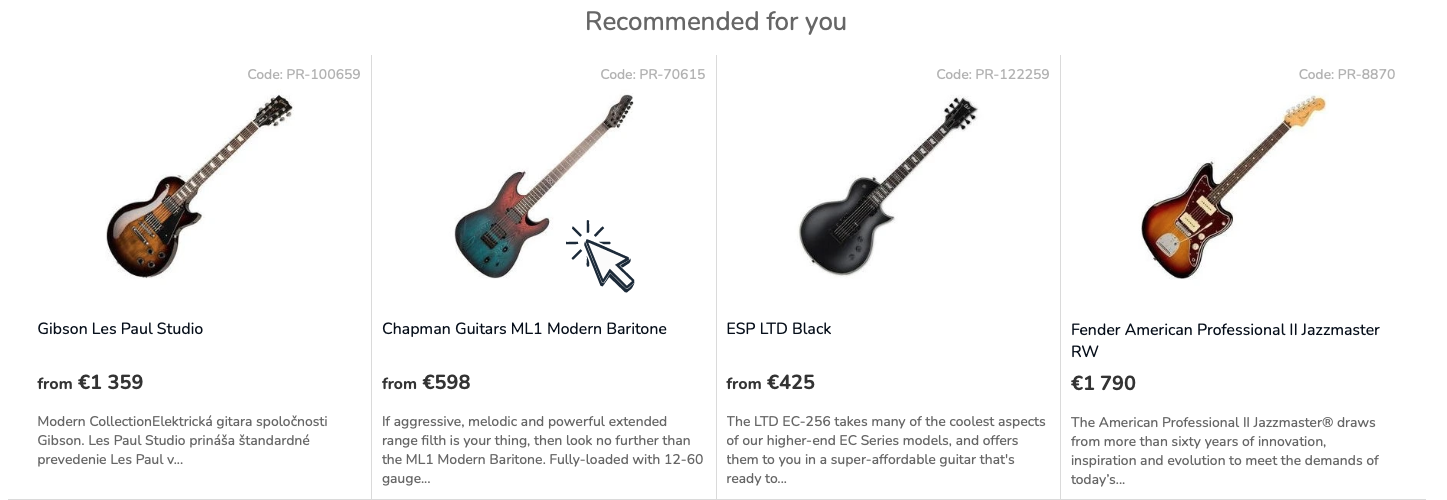
dataLayer.push({
event: "select_item",
ecommerce: {
items: [
{
item_id: "PR-70615",
}
]
}
});
Fire dataLayer customer_id event
dataLayer.push({
event: "luigisbox.collector.customer_id",
customer_id: "281827";
},
});
Once you know the personalized user ID, emit a customer_id dataLayer event. It is safe to emit the event just once per session, but it will not cause any problems if you emit it more than once per session.
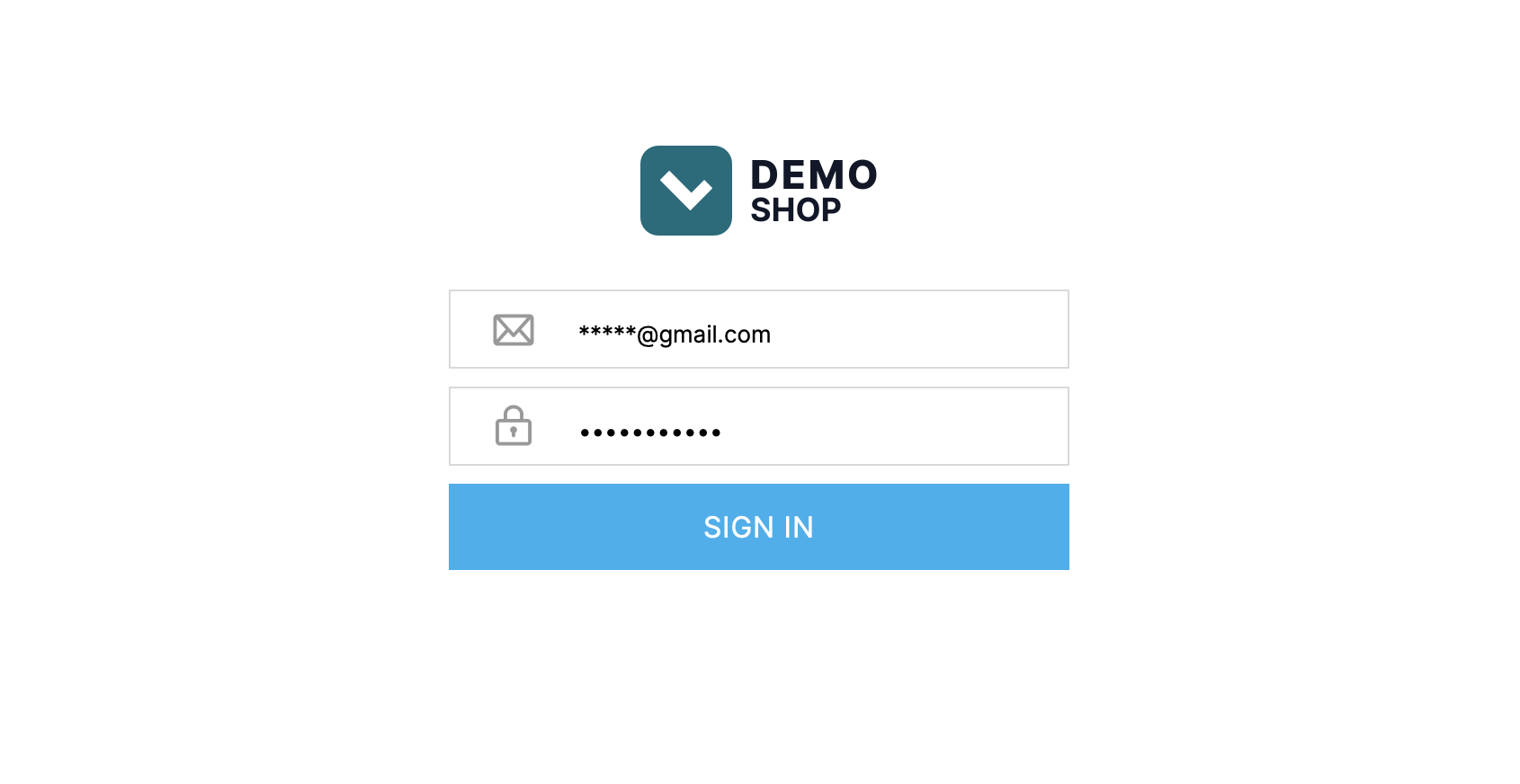
Make a request to recommender API for identified user
Make a request to the recommender API. This is a POST request with a JSON payload. Note that the only difference is in the value of the user_id parameter which now points to your internal user ID which you propagated to the dataLayer.
POST https://live.luigisbox.com/v1/recommend?tracker_id=<tracker_id>
[
{
"item_ids": ["PR-15553"],
"recommendation_type": "item_detail_complements",
"recommender_client_identifier": "item_detail_complements",
"size": 4,
"user_id": "<persistent_user_id>"
}
]
Tips
user_idis the persistent user id. It must be the same user ID you are propagating in the dataLayer event
Batch multiple recommendations into a single API request
For cases where you need to request recommendations for several different models, it is more efficient to issue a single request. This will be typically useful for scenarios where you are rendering several recommender boxes on a single page.
By asking for several recommendations in a single request you will also automatically avoid duplicate recommendations.
POST https://live.luigisbox.com/v1/recommend?tracker_id=<tracker_id>
[
{
"item_ids": ["PR-15553"],
"recommendation_type": "item_detail_complements",
"recommender_client_identifier": "item_detail_complements",
"size": 4,
"user_id": "<transient_user_id>"
},
{
"item_ids": [],
"recommendation_type": "last_seen",
"recommender_client_identifier": "last_seen",
"size": 6,
"user_id": "<transient_user_id>"
}
]
Tips
- Note that the payload is an array, as you can ask for several recommendations in a single request.
Limit amount of data transferred
To limit the amount of data transferred between systems, specify the hit_fields attribute in the API request. It is an array of result properties which will be included in the API response. By using this, you can significantly reduce the amount of data transfer and increase performance.
POST https://live.luigisbox.com/v1/recommend?tracker_id=<tracker_id>
[
{
"item_ids": ["PR-15553"],
"recommendation_type": "item_detail_complements",
"recommender_client_identifier": "item_detail_complements",
"size": 4,
"user_id": "<transient_user_id>",
"hit_fields": ["title", "image_link", "description", "price_amount"]
}
]
Tips
- Notice the
hit_fieldsattribute.
